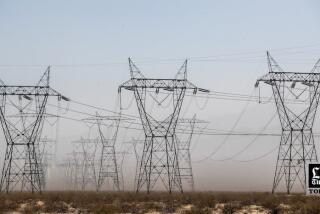A Zigzag Route to the Truth
- Share via
It was a screwy saga with a scientific twist.
In late April, two physicists announced in a prestigious physics journal that empty space spiraled like a corkscrew around some previously unknown axis, and that due to this mysterious turn of things, the universe had an upside and a downside.
For the record:
12:00 a.m. Aug. 8, 1997 For the Record
Los Angeles Times Friday August 8, 1997 Home Edition Part A Page 3 Metro Desk 2 inches; 42 words Type of Material: Correction
Science journals--An Aug. 7 article on the ambiguities of science should have stated that a paper on the cosmological axis by physicist John Ralston and Borge Nodland was submitted to only one scientific journal for publication. The Times had received erroneous information from several sources.
This meant, in effect, that the universe contained a kind of “north star” that oriented the cosmos. The finding upset many cherished ideas, including Einstein’s theory of gravity and the deeply held belief that everywhere one looks, space looks exactly the same.
Other scientists were skeptical.
Nevertheless, the story appeared on the front pages of many newspapers. Researchers responded with a half-dozen rebuttals on the Internet, poking holes in both the scientific data and the analysis. By week’s end, it seemed, the idea that the universe knows up from down was history.
“This is going to go away,” said University of Washington astronomer Christopher Stubbs on the day the paper was published. And, it seems, go away it did. Some scientists found the whole episode discouraging. Astrophysicist Lawrence Krauss of Case Western University worried that laypeople would be deluded--once again--”into thinking that science discovers lots of stuff which later on is always disproved.”
Scientists, in other words, would come off as people who don’t know which end is up.
At the same time, others suggest that the episode is an example of the way science ought to work, regardless of the validity of this particular study. It offered a glimpse inside the well-functioning, if messy, gears of real science, where wrong ideas are as important to the health of the enterprise as right ones.
Stumbling is not only inevitable, but necessary. “When people are trying to do very difficult things, it’s expected that some results will fall by the wayside,” said Caltech astrophysicist Roger Blanford. “If people were very conservative--if they always published only what they expected to find--there would be few new discoveries.”
Being wrong is not the worst thing that can happen to a scientist. Being “not even wrong,” as the late physicist Wolfgang Pauli put it, is far more devastating--because it means your idea isn’t even worth disputing.
Lately, there certainly have been enough wrong turns to go around, all of them fairly typical examples of science’s slow zigzag toward the truth.
* Recently, a group of astronomers said that the discovery of ice on the moon last year was not ice at all but probably a misreading of a spurious signal--much ado about nothing.
* Some “new” planets discovered orbiting stars other than our sun have faded away, as researchers have challenged the data.
* The sighting of house-size snowballs from space made an enormous splash, then melted into seeming oblivion.
* A new particle called a “leptoquark” was discovered at a particle accelerator in Europe, but now, it seems, the particle was probably a piece of stray noise.
“The public gets confused,” said Harvard University astronomer Sallie Baliunas, “because science is supposed to have hard rules, but these hard rules are applied by real people. It’s an important part of science that the public doesn’t see.”
As the late Carl Sagan liked to point out, science requires a strange mating of two contradictory tendencies: a willingness to consider even the most bizarre ideas, and at the same time, a most rigorous skepticism, requiring hard evidence to back up every claim.
A scientist must hover in a strangely divided state of mind--open to all, yet closed to anything but the most rigorously proven. Both perspectives are critical to scientific inquiry, and neither works without the other.
A New Twist
The twisted universe tale came into public view on April 21, when Physical Review Letters published a paper by physicists Borge Nodland of the University of Rochester and John Ralston of the University of Kansas. Although the paper was unobtrusively titled “Indication of Anisotropy in Electromagnetic Propagation Over Cosmological Distances,” the press releases accompanying it were not as subdued. In fact, the journal Science attributed much of the attention the paper received to “unrelenting promotion by the two universities’ press offices.”
Rochester called the discovery potentially “one of the most fundamental findings about the universe in recent years.” It certainly would have been extraordinary--assuming it were correct.
(Some researchers fear that pressure to get their institutions’ names in the headlines leads to premature news coverage of still-preliminary results.)
Ralston and Nodland based their conclusion on a statistical analysis of radio waves traveling through space from 160 distant galaxies. Radio waves are simply very long wavelength light, and just like visible light, they can be polarized to vibrate along only one plane. (Visible light reflecting off water and streets gets polarized in a horizontal plane, causing glare; Polaroid sunglasses block that horizontally vibrating light, making it easier to see.)
Astronomers agree that radio waves coming from distant galaxies are polarized. However, Ralston and Nodland said the plane of polarization rotated as the light traveled through space, like the twisted double helix of DNA.
Something in the universe, said Ralston and Nodland, was twisting the light. What’s more, the light got more twisted the more it receded farther into the universe--suggesting that whatever was causing the twist was a truly universal phenomenon.
Finally, the universe appeared to twist in different directions: It twisted like a right-handed screw if you looked in one direction, a left-handed screw in the other.
If true, this would have undermined a central tenet of cosmology (so central it’s known as the “cosmological principle”): that the universe looks the same no matter where you look.
Since the days when people thought the Earth was the center of everything, astronomers had come to the conclusion that the center is everywhere and nowhere. “We’ve come 180 degrees,” said astrophysicist Rocky Kolb of the University of Chicago. “There ain’t no center,” he said. “There ain’t no special direction.”
The idea that the universe has no direction has withstood every test science has put to it for 65 years, “until last Tuesday,” he joked (when the paper came out).
Everywhere you look, every instrument finds a remarkably uniform universe--with the same configurations of galaxies, the same densities of matter, the same temperature fluctuations, in every possible direction.
What’s more, if the universe isn’t the same in all directions, that could imply that the Big Bang that created the cosmos was somehow not perfectly symmetrical. For now, no theory accommodates such a notion.
Furthermore, the shape of the universe, as well as the way light travels through it, are well understood by Einstein’s two theories of relativity--both of which would have to be revised if the cosmos is really a corkscrew.
Given the enormous implications--not to mention the media attention--it’s not surprising that researchers reacted quickly. Several papers posted on the Internet argued that the statistical methods used were misleading, and produced effects that weren’t real. Others said the data used was old and incomplete.
To date, Ralston and Nodland are still defending their work.
More interesting than whether the twist in space is right or wrong, however, is what this tale says about the scientific process. Any scientists worth their salt come up with wild ideas from time to time. But experimenters have to have the data to back ideas up.
“One of the most difficult questions in science,” said UC San Diego physicist Robert Dynes, “is how do you know when it’s [garbage]?”
Astrophysicists may have the hardest time of all answering this question. After all, they can’t do controlled experiments on distant stars and galaxies. The best they can do is observe.
“Astrophysics is a discipline where the facts don’t always agree with each other,” said Stubbs. “So people use subjective judgment to assemble a self-consistent world view. You can sift through the things that are out there to support any kind of cockamamie argument.”
Sifting Theories
Scientists devise their own sets of rules to decide which ideas are worth pursuing, based on some combination of common sense, instinct and experience. They may also try out their more cockamamie views on trusted colleagues before publicly stepping out on a limb.
But how do they guard against getting sucked in by unreliable data published by others? What standards do they use?
First, they look to see if a paper has been peer reviewed--that is, scrutinized by fellow scientists for accuracy and completeness. The paper on the cosmic corkscrew did pass peer review, but not without problems. It had been making the rounds for a long time, submitted to various scientific journals before it got published. But peer review isn’t a perfect sieve that lets in only the “right” papers and rejects only the “wrong” ones.
“I think you’d find that the rejection rate for scientific papers is pretty low,” said Caltech astronomer Chuck Steidel. “Sooner or later, anything can get published.”
“I don’t know how [the corkscrew theory] got published,” said Toronto University radio astronomer Philipp Kronberg. “Something that is so obviously incompatible with the data is going to be shot down pretty fast. [Still,] these things do get through the cracks.”
On the other hand, some of Einstein’s papers almost didn’t pass peer review. And as Ralston has pointed out, none of the rebuttals that appeared on the Internet passed peer review.
Second, scientists look at the reputations of the researchers making what seem like outrageous claims. When NASA talked about finding evidence of ancient fossil life on Mars, scientists listened in part because one of the researchers involved was Stanford’s Richard Zare, a widely trusted chemist.
The names of the authors of the twist paper were not widely known in the astrophysical community. “These people don’t have any particular reputation,” said Steidel. Still, he was quick to add, “‘there are lots of good people I haven’t heard of.”
Both authors hold positions at prestigious universities. And outsiders occasionally do make important discoveries.
Third, researchers tend to put more faith in discoveries they expect to find. “You require different levels of proof depending on whether you’re looking for something,” said Kolb. “If you see something that you don’t expect to see, the standard of evidence is higher. I don’t think this [the twist in space] is at the standard of evidence that people are going to abandon the cosmological principle.”
Finally, it helps if the discovery has some logical or compelling explanation. “Some correlations are not meaningful,” said Baliunas, who also directs science at Mt. Wilson Observatory. “I like to think that there’s a mechanism behind [the correlation], that there’s an explanation that makes sense.”
Open to New Ideas
By all these standards, scientists found many reasons to be skeptical about the screwy shape of space. But at the same time, they were equally aware of that other important ingredient in scientific exploration--openness to new and even outrageous-sounding ideas.
The odds that the paper was right are probably slim, said Kolb, but “people buy lottery tickets with worse odds. It’s not a crank paper. It’s not a stupid thing to look at.”
And while Ralston and Nodland would love to have their conclusions vindicated, they at least got other scientists to look at the findings and consider the implications. “It’s not a mainstream thing,” Ralston said. “But I’m trying to get some cosmologists and particle physicists worked up about it.”
In that, he was quite successful. In the end, the saga turns out to be a fine example of science working just as it probably should--not perfectly--but the best it can.
“Often, the truth of results aren’t clear,” said Kronberg. “But that is in the nature of science.”
The winnowing out is natural. Scientists should be able to change their minds, or not make up their minds at all. Two minds can be better than one--even when they co-inhabit the same cranium.
“I almost view myself as schizophrenic,” Baliunas said. “I get up in the morning believing one thing, and then I read a paper, and then I believe something else.”
(BEGIN TEXT OF INFOBOX / INFOGRAPHIC)
Twisted Logic?
Other scientists have cast serious doubt on a widely publicized theory by two physicists who say empty space spirals like a corkscrew around some previously unknown axis.






